Integrating Hanging Fake Plants in Interior Design
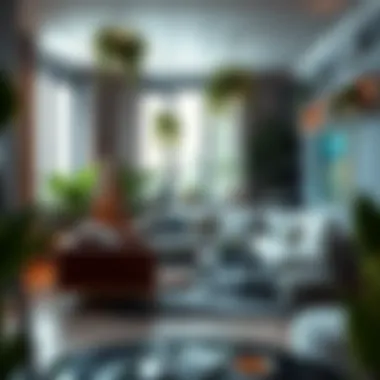
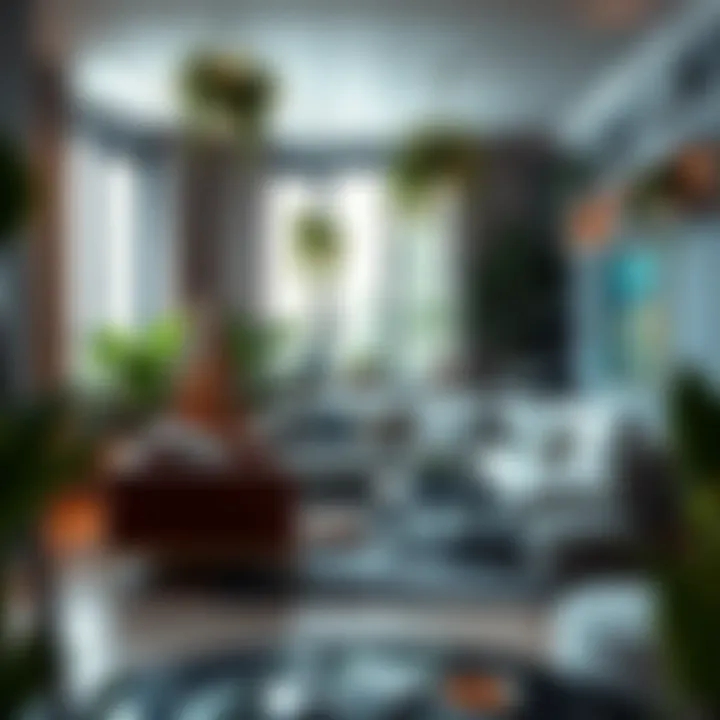
Intro
In recent years, the integration of hanging fake plants into interior design has sparked significant interest among homeowners and design aficionados alike. Unlike their living counterparts, these artificial greens provide an aesthetic charm without the hassle of upkeep. Moreover, they can transform any dull space into a lush and inviting atmosphere. The purpose of this article is to dive deep into the art of using hanging fake plants effectively while shining a light on their relevance within modern interior design.
Artificial plants, particularly those that can be hung, serve multiple roles in enhancing living spaces. Beyond mere decoration, they bring a touch of nature indoors, which can positively impact wellbeing. Whether you're a seasoned interior designer or a homeowner looking to spruce up your rental, the practicalities of selecting, installing, and maintaining these plants will be explored in detail.
Throughout this guide, you will learn about the intersection of furniture styles and current trends, as well as practical tips for choosing the right hanging plants for your home. The balance between style and sustainability will also be considered, a growing concern in today's eco-conscious society. By weaving these elements together, let's embark on a journey to redefine how artificial greenery can enrich our environments.
Prelude to Hanging Fake Plants
The use of hanging fake plants in interior design has carved out a niche that has steadily gained traction in recent years. This section seeks to underscore the significance of this trend and how it seamlessly integrates into various aesthetic frameworks. As many homeowners and decorators circle around this burgeoning interest, understanding the core aspects of faux greenery becomes paramount.
This exploration is not merely about placing plants in attractive spots around the home; it is about incorporating these artificial beauties in a manner that elevates the overall design ethos of any space. With their increasing affordability and improved realism, hanging fake plants offer a multitude of benefits that cannot be overlooked.
The Rise in Popularity of Artificial Plants
In recent years, the trend for artificial plants has surged, and for good reason. Once considered a poor substitute for the real deal, modern technology has allowed for the production of fake plants that are remarkably lifelike. Take, for instance, brands like Nearly Natural and Afloral, which have perfected the art of crafting faux greenery that often fool even the keenest of eyes.
As urban living becomes a mainstay, so does the demand for low-maintenance decor. People are increasingly seeking solutions that align with their busy lifestyles. Not everyone has the time or the green thumb to nurture living plants, which is why faux options have exploded in popularity. Furthermore, there's been a notable cultural shift towards earth-conscious choices, making artificial plants catching up due to their sustainability factor over time. In some cases, you could argue that faux plants are the unsung heroes of home decoration, striking a perfect balance between beauty and pragmatism.
Why Choose Fake Over Real?
Opting for fake plants over real ones presents several undeniable advantages, particularly in urban settings where space and resources may be limited. For starters, they eliminate the need for watering, repotting, and ensuring adequate sunlight. This alone can save you hours each week, letting you focus on other tasks or simply enjoying your space.
Furthermore, no need to worry about pests. Unlike live plants that can invite unwelcome guests such as insects or mold, faux plants remain defensively visual – they simply sit pretty, enhancing your decor without adding the burden of upkeep. You can also rearrange them without concern for seasonal changes, lighting conditions, or watering schedules, making them a flexible option for dynamic interior designs.
Let's not forget the versatility of artificial plants. They come in a myriad of colors, shapes, and sizes that can be tailored to fit any design scheme or personal taste. From the tall, elegant trailing vines that mimic the look of a lush rainforest, to petite arrangements that could fit snugly on a windowsill, there is virtually no limit to how one can use these designs. The faux plant revolution offers style without the hassle, promising an ever-expanding potential for interior design infusion.
Aesthetic Considerations
In the world of interior design, aesthetic considerations play a pivotal role. They breathe life into an otherwise static space, transforming it into something vibrant and engaging. When it comes to incorporating hanging fake plants, the aesthetics involved go beyond mere decoration. They evoke feelings, create atmospheres, and significantly impact how a space is perceived. Faux greenery not only adds a fresh touch but also serves as a versatile element that can complement various styles and themes.
Visual Appeal and Design Integration
The visual appeal of hanging fake plants is hard to underestimate. These artificial beauties can dramatically enhance the overall look of a room. Imagine entering a room where plants dangle gracefully from the ceiling, adding depth and character to the space. They can act as focal points or subtle accents, depending on how they are positioned.
Integrating them into your design scheme requires a keen eye. Consider the overall style of your interior—whether it's minimalist, rustic, or modern. For instance, if your space leans towards a bohemian vibe, opt for exuberant greenery like trailing vines or ferns, cascading elegantly from handcrafted hangers. On the flip side, for a sleek contemporary look, choose more structured designs or succulents displayed in clean-lined containers. Whatever the case, positioning these faux plants at varying heights can engage the eye and create an intriguing narrative within the design.
Color and Texture Choices
Diverting attention to color and texture, one must recognize that these two elements are fundamental in creating a harmonious environment. While fake plants don’t change with the seasons like real ones, they still offer an array of colors and textures that can be seamlessly melded into your design. From vibrant greens that mimic lush foliage to subtle pastels, the color palette should match or accentuate the existing tones of your room.
Texturally, mixing different materials can create depth. Combining a sleek ceramic pot with the rustic charm of a woven basket, for example, offers a nice contrast while showcasing the faux plant effectively. When potted together in clusters, varying textures and colors can imbue a space with warmth and energy.
The Role of Height in Interior Spaces
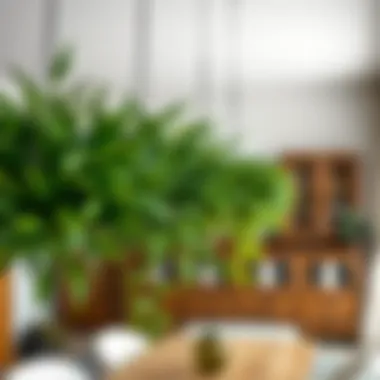

Height is often an overlooked yet crucial aspect in interior decor, particularly when utilizing hanging faux plants. The higher the plants are hung, the greater the illusion of space and airiness one creates in a room. It’s an old trick of the trade—high placement of greenery draws the eye upwards, giving the impression of higher ceilings and more open areas. This can be particularly beneficial in smaller rooms.
On the other hand, lower placement can foster a sense of intimacy. For example, a well-placed hanging plant near a dining area can make the space feel cozy and inviting. The balance of height achieves a layered look—creating levels that add dimension. Remember, it’s all about finding that sweet spot. Overcrowding a ceiling with too many hanging plants might overwhelm, while just the right amount can elevate the room's aesthetic effortlessly.
Practical Benefits of Hanging Faux Plants
Hanging faux plants have become a quintessential element in modern interior design for several valid reasons. Aside from their captivating aesthetic, they offer an array of practical benefits that elevate both the functionality and ambiance of a space. Making an informed decision about incorporating these plants can significantly enhance one’s living or working environment. Here, we will delve into two major practical benefits that are indispensable: their low maintenance requirements and allergy considerations.
Low Maintenance Requirements
One of the standout advantages of hanging fake plants is their incredibly low maintenance needs. Unlike their live counterparts, these faux greenery pieces don’t require any watering, trimming, or unusual sunlight exposure to thrive. Imagine placing a stunning draping fern in a corner, and forgetting about it; no daily fuss, no logistics of peeking every so often to ensure it’s still alive. They stand resilient against the elements, making them perfect for even those uncommon spaces that get little to no light.
For busy homeowners or professionals, this benefit is invaluable. Instead of worrying about brown leaves or wilting petals when life gets too busy, you’re free to enjoy effortless charm. These plants are also not picky about temperature or humidity, thus removing the pressure of maintaining an ideal climate. A quick wipe with a damp cloth now and then is all you need to keep them looking fresh.
Allergy Considerations
Another noteworthy point is that hanging faux plants eliminate a common issue faced by many— allergies. For individuals susceptible to pollen or certain molds typically associated with real plants, integrating a few stylish faux varieties into the decor can be a breath of fresh air, in a manner of speaking.
It's important to note that some might argue artificial plants lack the authenticity of real flora. However, these faux versions are largely made from materials that do not trigger allergies. This means homeowners can enjoy the beauty and benefits of foliage without suffering from the sneezes or other allergic reactions.
"Artificial plants offer all the aesthetics with none of the sneezes."
Selecting the Right Plants
Selecting the right plants for your interior space is akin to choosing the right clothes for an occasion: it can transform the entire atmosphere. When it comes to hanging fake plants, making informed choices ensures they not only beautify a space but also convey a particular vibe or theme. A well-selected faux plant can breathe life into a room, while a poor choice might simply gather dust.
Material Quality and Authenticity
The material quality of artificial plants plays a pivotal role in their overall effect. High-quality faux plants are usually made from polyethylene or polyester, giving them a texture that closely mimics the real thing. These materials can replicate intricate details like leaf veins and subtle gradients in color. When choosing a hanging plant, look for one that feels realistic to the touch. If you can make a mistake without a second thought of what might break the bank, opt for ones with soft, pliable leaves that sway gently. This touch-and-feel test can oftentimes reveal the hidden gems among the otherwise average choices.
"Investing in high-quality materials can mean the difference between faux that looks plastic and faux that whispers class."
Furthermore, authentic-looking features—like slight imperfections in leaf shapes or variations in color—can elevate the aesthetic appeal. When shopping, it helps to compare different options side by side; this side-by-side evaluation brings insights that online browsing might miss.
Size and Shape Variations
When integrating hanging plants into your space, size matters. The grandness or modesty of your selection impacts visibility and perception. For instance, a larger cascade of faux foliage can be a statement piece, drawing eyes upwards and creating an illusion of height in a room with low ceilings. On the flip side, smaller hanging plants might serve as gentle accents that quietly enhance a decor theme without competing for attention.
Choosing the right shape is equally crucial. A sprawling, rounded plant might pair better in a corner with ample light, creating a lush, full effect, whereas a tall, slender piece can accentuate vertical spaces above furniture, like bookcases or consoles. Ensuring variety in sizes and shapes not only pleases the eye, it also maintains visual interest.
- Large, bushy options can add fullness, often great for corner placements.
- Slim, trailing varieties, such as string of pearls, are perfect for narrow spots.
- Pick irregular shapes to break monotonous lines in structured spaces.
Choosing Plants for Different Spaces
The ideal fake plant is one that compliments the ambiance and function of each unique space. Assessing the character of your area can direct you towards suitable selections. For instance, in a cozy reading nook, a soft, leafy plant like hanging pothos can impart a relaxing atmosphere, inviting one to curl up with a book. In contrast, in a modern kitchen, a hardy option like fake cactus could infuse a bit of character without demanding much maintenance.
Each room has its own energy; visualize the lifestyle happening there before making your choice:
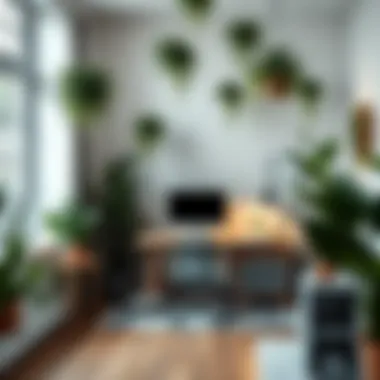

- Outdoor-inspired areas: Vibrant ivy or fern imitations can transport you closer to nature.
- Minimalist spaces: Opt for a singular, striking piece rather than cluttering with too many.
- Creative zones: Whimsical plants with unusual colors can ignite inspiration.
In all, selecting the perfect plant for your hanging setup revolves around examining material quality, size variations, and the essence of the space. This careful selection process can significantly enhance the visual narrative of your interiors.
Installation Techniques
Integrating hanging fake plants into your interior design requires careful thought regarding installation. Proper installation techniques ensure that your faux greenery complements your space, both visually and structurally. The benefits of focusing on installation include enhancing the overall aesthetic, ensuring safety, and improving the longevity of your decor.
Hanging Methods and Tools
When it’s time to hang those faux plants, you’ve got options. Some popular methods include:
- Ceiling Hooks: These are a classic choice for securing pots or planters. They’re simple to install and can hold moderate to heavy weights. Make sure to install into a ceiling joist for maximum support.
- Wall-Mounted Planters: If ceiling space is tight, wall-mounted solutions work wonders. They provide a sleek look and can be arranged in various layouts to create visual interest.
- Macramé Hangers: These not only hold your plants but also add texture. They come in various designs and can be adjusted to create different hanging lengths.
- Hanging Shelves: For a more substantial setup, consider installing shelves specifically designed to hold plants. This not only gives plants a stable base but also allows for creative arrangements.
Make sure you have the right tools on hand before you start:
- Drill and anchors (if needed)
- Screwdriver
- Measuring tape
- Level
- Safety goggles
These tools help ensure your installation goes smoothly, resulting in beautifully displayed plants that won’t fall or collapse under weight.
Creating Balance and Symmetry
Creating a balanced and symmetrical arrangement is crucial when adding hanging plants. This doesn’t mean every piece must mirror another, but rather that the visual weight should feel harmonious throughout the space. Here’s how you can achieve that:
- Consider Heights: Varying the heights of hanging plants can add dimension while still keeping a cohesive look. For example, hanging one plant lower and another higher creates a flow that draws the eye.
- Group Similar Plants: Group plants of similar sizes or colors together to form clusters. This approach can establish focal points in a room and maintain balance without overwhelming the senses.
- Pair with Other Décor: Consider the furnishings and wall art around your plants. Striking a balance between hanging greenery and other elements enhances the overall interior aesthetic. A well-placed faux plant can soften the edges of a room filled with hard furniture or artwork.
"The secret lies in layering different heights and forms. Your faux plants shouldn’t just dangle— they should tell a story, guiding the eye through the room."
Incorporating these installation methods and balance techniques will allow you to skillfully integrate hanging fake plants in a way that feels intentional and visually striking. As a result, your selected decor will create a lasting impression and a cohesive look throughout your interior space.
Design Tips for Effective Use
Integrating hanging fake plants into your interior design can elevate a space in ways that are both aesthetically pleasing and practical. However, without a careful approach, the potential of these faux greens can be lost. Thus, this section aims to discuss effective design strategies that not only showcase artificial plants beautifully but also harmonize them with other elements in your decor.
The art of using hanging plants effectively involves much more than merely placing them in any available corner. It requires thoughtfulness regarding color, texture, and overall layout. When done correctly, hanging fake plants can serve as focal points or subtle accents that add layers of interest to a room. Here’s how to get the most out of these versatile pieces.
Layering with Other écor Elements
Layering is a design technique that can create depth and intrigue. By placing hanging fake plants in conjunction with other decor items, you weave a more complex and inviting aesthetic. Here are some ways to layer effectively:
- Mixing Textures: Combining different materials can add a tactile dimension to your space. For instance, place a hanging plant with a macrame holder next to a smooth ceramic vase. This contrast allows each piece to stand out while drawing the eye across the display.
- Utilizing Color Palettes: Coordinate the colors of your hanging plants with the hues found in wall art or throw pillows. For example, a hanging fern with lush green leaves can be complemented by cushions featuring similar shades, creating a robust visual dialog in the room.
- Creating Levels: When arranging your decor, consider varying heights. Suspended plants can be set against lower items, like a coffee table or floor cushions. This intentional positioning emphasizes the height of the plants and creates a dynamic visual landscape.
Remember: Layering is all about balance. Avoid overcrowding your space; choose a few standout pieces and allow breathing room.
Complementing Furniture Choices
The relationship between hanging plants and your furniture is crucial. When selecting the positioning of faux flora, consider nearby furniture to enhance the overall aesthetic. Here’s how they can complement one another:
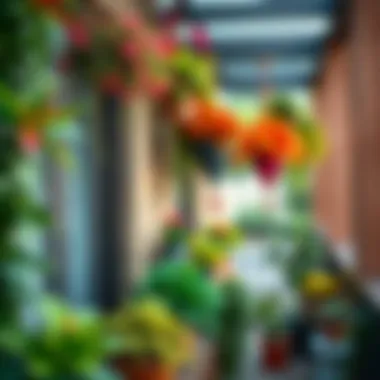
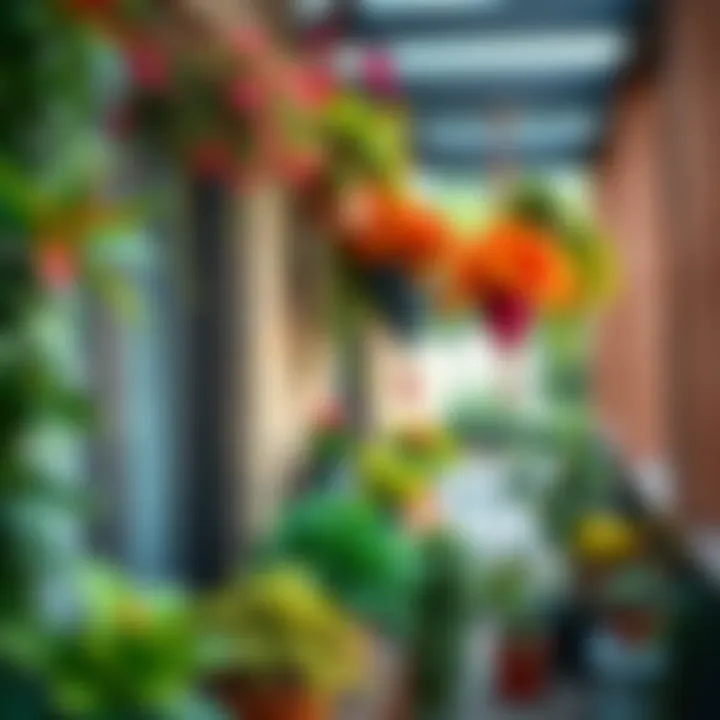
- Aligning Styles: If your furniture has a modern design, opt for sleek, minimalistic hanging plants with clean lines. Conversely, if your decor leans towards a vintage aesthetic, lush, cascading plants can add sophistication to the environment.
- Creating Cohesion: Use hanging plants to tie different areas of a room together. For example, if your dining area features wooden elements, hang natural-looking plants with earth tones nearby to create a sense of unity with the furniture.
- Framing Views: Use hanging arrangements to frame key pieces of furniture. If you have an eye-catching armchair or a unique coffee table, suspend plants around them to enhance their significance in the room’s layout.
In summary, the integration of hanging fake plants can be both functional and striking, given the right design tips. Leveraging layering and aligning with furniture choices transforms these pieces from mere decor into essential elements that define the space. Keep experimenting, and you'll find the perfect balance that speaks to your personal style.
Trends in Artificial Plant Designs
As we navigate through the ever-evolving landscape of interior design, the implementation of hanging fake plants has become a hallmark of contemporary aesthetics. Understanding the trends surrounding artificial plant designs goes beyond mere decoration; it’s about adapting to modern sensibilities of style, maintenance, and sustainability.
By integrating faux greenery, homeowners and designers can curate spaces that are not only beautiful but also functional. This understanding aids in harmonizing personal style with the practicalities of everyday living.
Current Aesthetic Trends
The current aesthetic trends in the realm of artificial plants often reflect broader design shifts. Elements such as minimalism and biophilic design dominate today’s landscapes. With that in mind, here are some key aspects:
- Minimalistic Designs: A shift towards simplicity has become commonplace. Clean lines and understated designs encourage a serene and uncluttered environment. Hanging plants, often seen in geometric planters, offer a crisp look that aligns with minimalist aesthetics.
- Naturalistic Looks: The demand for authenticity is increasing, pushing manufacturers to focus on creating more lifelike representations of plants. Textures resembling real leaves and organic shapes are now standard, helping to bridge the gap between faux and real.
- Bold Colors: Also, there’s no denying the popularity of bold, vibrant colors. Whether it’s rich greens or unusual hues, these plants make striking focal points in otherwise muted spaces.
- Layering Techniques: Designers increasingly use plants to create a layered effect within their spaces. This involves the strategic placement of plants at varying heights and depths, allowing for a more dynamic visual narrative.
"In the balance of design, plants are more than just decoration; they are the silent storytellers of a space."
Sustainability in Artificial Plant Manufacturing
As more individuals become environmentally conscious, the demand for sustainability in the production of artificial plants is rising. This awareness shapes purchasing decisions among homeowners and designers alike. Key points to consider include:
- Material Choices: Manufacturers are turning to eco-friendly materials, finding alternatives to traditional plastics. For instance, some companies are now using recycled plastics or biodegradable compounds to create faux plants that lessen environmental impact.
- Durability: An often overlooked aspect of sustainability is durability. High-quality artificial plants can last for years, reducing waste compared to frequently replacing cheaper alternatives.
- Ethical Production: Transparency in the supply chain is becoming crucial. Consumers want to support companies that prioritize ethical practices, ensuring workers are treated fairly during the manufacturing process.
Challenges and Solutions
Integrating hanging fake plants into any space can be a delightful endeavor. However, the journey isn't without its share of challenges. Addressing these hurdles is crucial for ensuring that the overall aesthetic isn't compromised and the intended ambiance is achieved. Understanding the typical concerns that homeowners and designers may have can lead to more effective solutions and optimal outcomes.
Perceptions of Authenticity
When it comes to artificial plants, the first roadblock many face is the perception of authenticity. It's common for individuals to believe that faux greenery cannot replicate the beauty of real plants. This belief can stem from past experiences with low-quality imitations that look plasticky or unrealistic. It’s imperative to change this mindset; not all artificial plants are created equal.
To navigate this perception, seek high-quality options that boast realistic textures and colors. Top-tier brands often utilize materials that mimic the natural grain and sheen of live plants. Additionally, consider the placement and arrangement of these faux plants; positioning them near natural light or alongside genuine pieces can blur the line between the real and the artificial.
End
In the world of interior design, the incorporation of hanging fake plants represents a nuanced blend of practicality and aesthetic allure. This article has traversed the multifaceted aspects of integrating these decorative elements, underscoring their growing significance in contemporary spaces.
Summarizing Key Points
To encapsulate the discussion:
- Aesthetic Appeal: Hanging fake plants add texture, height, and vibrancy to various interior setups. They find their sweet spot in homes, offices, and other environments, contributing to a fresher look.
- Practical Benefits: One of the strongest arguments for faux over real is the ease of maintenance. No watering, no mess. They also cater to allergy sufferers, allowing everyone to enjoy greenery without the sneezes and wheezes.
- Selection and Installation: Choosing the right materials and sizes align with the overall decor. The installation techniques discussed ensure that these plants are not merely an afterthought but rather a focal point that enhances the existing design.
- Trends and Sustainability: Modern faux plants are designed with a keen eye on sustainability, catering to environmentally conscious buyers who want aesthetic appeal without compromising their values.
These key points remind us that hanging fake plants are not just decorative pieces; they serve as a bridge between form and function in design.
Future of Decorative Faux Plants in Design
Looking ahead, the future of decorative faux plants seems bright. With continual advancements in design and manufacturing processes, their realism will only improve, broadening their appeal. As sustainability gains traction, the next wave of artificial plants will likely focus on environmentally friendly materials and processes, meeting the demands of eco-aware consumers.
For homeowners and designers, integrating these plants will likely involve a deeper understanding of how they can complement emerging design styles. Possibilities are endless—think of combining faux plants with technology, like integrating smart features into plant holders or adapting designs for vertical gardens in compact living spaces.
Overall, decorative fake plants will continue to be an integral part of interior design conversations, bridging practicality with the knowledge that bringing a bit of nature indoors can enhance our living environments. As you navigate this evolving landscape, consider how these solutions can be tailored to fit both your style and your needs.















